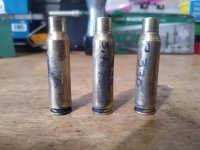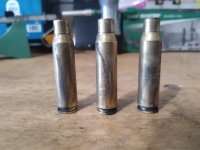I started shooting my Remington 700, 308 last week, and with 2 different 168 grain bullets, cfe223 new batch of powder and also does it with Lapua and Hornady brass, both loaded several times.
I am just confused, because I have shot these loads last year and never had sooting, and now it is sooting bad, but also strange is it only does it with CFE223 powder that I just purchased 5 pounds online about a month ago.
Could a powder problem actually cause this, or like I said, am I trying to get too many reloads out of brass that never has been annealed?
It has done this with my gun with 20 rounds through it after cleaning, and also did the same thing with about 90 rounds since being cleaned.
Several other kinds of brass and Imr 4064, and Reloder 15 had no problems, no sooting.
I am thinking of taking these latest Lapua rounds apart, which I only shot 3 out of the 30 of them and try loading them in some once fired Hornady brass, which still should be not work hardened and see if it stops.
Also I have been trimming my brass every time now, to .005 less than minimum, 2.000 instead of 2.005. Could this be causing the sooting?
Thanks for any advice
I am just confused, because I have shot these loads last year and never had sooting, and now it is sooting bad, but also strange is it only does it with CFE223 powder that I just purchased 5 pounds online about a month ago.
Could a powder problem actually cause this, or like I said, am I trying to get too many reloads out of brass that never has been annealed?
It has done this with my gun with 20 rounds through it after cleaning, and also did the same thing with about 90 rounds since being cleaned.
Several other kinds of brass and Imr 4064, and Reloder 15 had no problems, no sooting.
I am thinking of taking these latest Lapua rounds apart, which I only shot 3 out of the 30 of them and try loading them in some once fired Hornady brass, which still should be not work hardened and see if it stops.
Also I have been trimming my brass every time now, to .005 less than minimum, 2.000 instead of 2.005. Could this be causing the sooting?
Thanks for any advice


